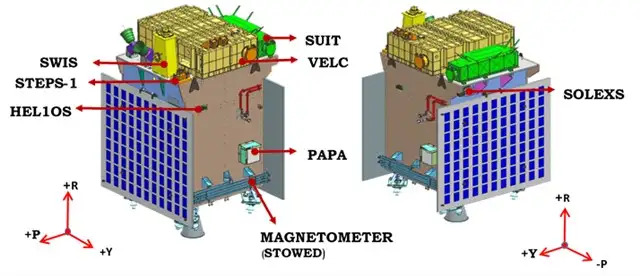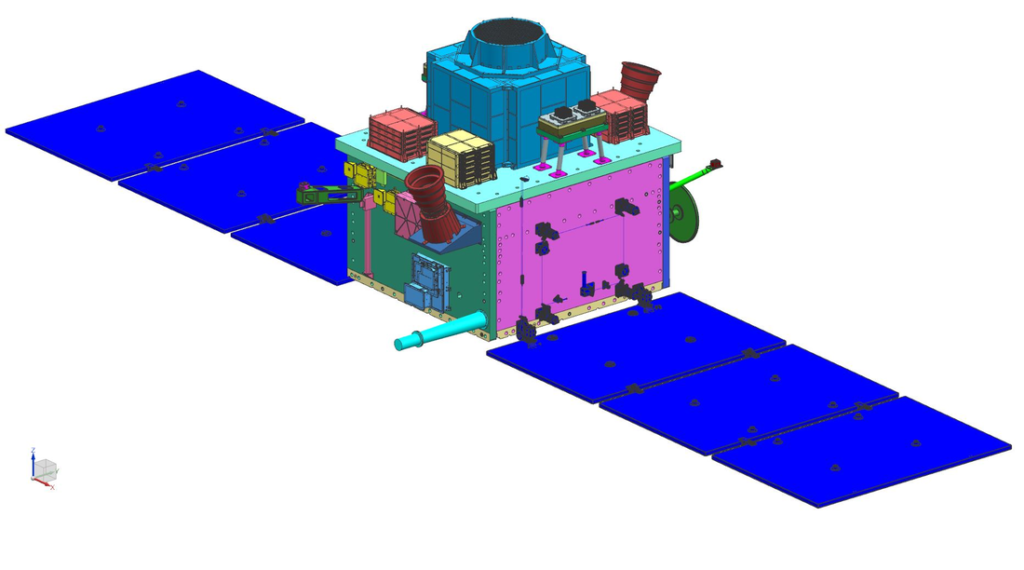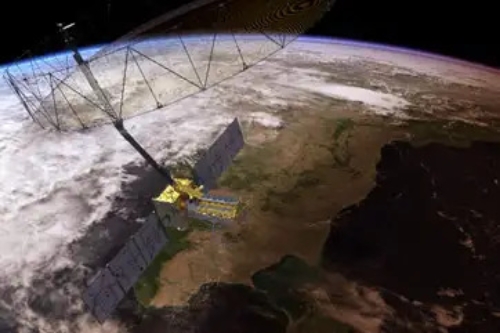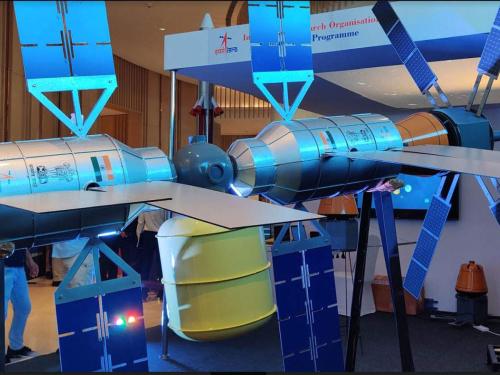After the resounding success of Chandrayaan-3, ISRO (Indian Space Research Organisation) continues to soar to new heights in its pursuit of space exploration. With an unwavering commitment to technological innovation and scientific advancement, ISRO has an impressive lineup of upcoming missions that promise to unveil the mysteries of the cosmos. Let’s take a closer look at these exciting missions that are set to captivate our imaginations.
Upcoming ISRO Missions
Aditya L1: Exploring the Sun

Aditya L1, an upcoming Indian space mission, is all set to embark on an extraordinary journey to study the Sun, our closest star. This mission is going to be a trailblazer as it will be India’s first-ever space-based mission dedicated to understanding the Sun and its effects on our space environment.
The Sun’s Halo Orbit:
Aditya L1’s spacecraft will be positioned in a unique halo orbit around a point called Lagrange point 1 (L1) in the Sun-Earth system. This special point is located about 1.5 million kilometers away from Earth. The halo orbit provides a fantastic advantage: it allows the spacecraft to have an uninterrupted view of the Sun without any interruptions like eclipses or occultations.
Unveiling Solar Mysteries:
Equipped with seven payloads, Aditya L1 is geared up to explore different layers of the Sun – the photosphere, chromosphere, and the outermost layer known as the corona. These payloads come with electromagnetic, particle, and magnetic field detectors. Four of them are specifically designed to directly observe the Sun, while the other three will perform in-depth studies of particles and fields at the L1 point.
Real-time Space Weather Insights:
Aditya L1’s positioning at the Lagrange point L1 is a game-changer. This position allows it to capture real-time information about the Sun’s activities and how they influence space weather. This is crucial because understanding space weather helps us comprehend its effects on our communication systems, power grids, and satellite operations.
Unlocking Solar Secrets:
The payloads on Aditya L1 are like a team of detectives, on a mission to unravel the Sun’s mysteries. They will provide vital information about various phenomena like coronal heating, coronal mass ejections, pre-flare, and flare activities. Additionally, they will study how particles and fields move through space, giving us insights into the dynamic interplay of solar forces.
XPoSat Mission: Unraveling Astronomical Mysteries

Step into the world of XPoSat, India’s pioneering X-ray Polarimeter Satellite, on a remarkable mission to decode the secrets of bright astronomical X-ray sources. With a unique focus on extreme conditions, XPoSat is poised to revolutionize our understanding of celestial phenomena.
XPoSat’s Unique Mission:
XPoSat isn’t just another satellite; it’s a trailblazer in the realm of polarimetry. Its primary aim is to delve into the intricate dynamics of bright astronomical X-ray sources, such as black holes, neutron stars, active galactic nuclei, and pulsar wind nebulae. These enigmatic sources emit X-rays through complex physical processes that have puzzled astronomers for years.
Dual Payloads for In-depth Insights:
Zooming through a low Earth orbit, XPoSat carries two scientific payloads that promise groundbreaking insights. The first, POLIX (Polarimeter Instrument in X-rays), is a high-tech instrument designed to measure the degree and angle of polarization of X-rays falling within the medium energy range of 8-30 keV. This range is critical for understanding the nature of X-ray emission from celestial bodies.
Decoding Emission Processes:
The heart of XPoSat’s mission lies in its ability to provide vital polarimetric measurements. By analyzing the degree and angle of polarization of X-rays, scientists gain a new dimension of understanding about emission processes. These measurements act as a powerful diagnostic tool, enabling us to unravel the intricate mechanisms behind the X-ray emission from various astronomical sources.
Adding Depth to Spectroscopy:
XPoSat’s second payload, XSPECT (X-ray Spectroscopy and Timing), is no less impressive. Operating within the energy range of 0.8-15 keV, XSPECT provides essential spectroscopic information. This means it can break down X-rays into their constituent energies, allowing scientists to understand the distinct characteristics of X-ray emissions from different sources.
Charting New Avenues of Research:
The world of astronomy is brimming with questions, and XPoSat is here to provide answers. The combined power of polarimetric and spectroscopic measurements is expected to bring clarity to complex emission processes. This, in turn, will aid in distinguishing between various theoretical models and shed light on the true nature of celestial phenomena.
Also Read: 6 Lesser Known Indian Women Scientists You Might Never Read in Text Book
NISAR: Mapping Earth’s Changes for a Better Future

Imagine having a powerful eye in the sky that can see and understand the ever-changing face of our planet. NASA and ISRO are teaming up to make this vision a reality with the NASA-ISRO Synthetic Aperture Radar (NISAR) mission. This remarkable collaboration aims to map the entire globe in just 12 days, offering a wealth of information about Earth’s ecosystems, ice, vegetation, and much more.
A Unique Earth Watcher:
NISAR is like a vigilant guardian orbiting our planet in Low Earth Orbit (LEO). Its task? To observe and comprehend the changes happening on Earth’s surface. From the rise of sea levels to shifts in ice masses, the mission is set to offer valuable insights into everything that impacts our world.
A Symphony of Data:
The magic behind NISAR lies in its ability to provide consistent data that capture both space and time. This means it can reveal how Earth’s landscapes evolve over days, months, and even years. This is crucial because it helps us understand shifts in ecosystems, the growth of vegetation, and the movement of ice.
Monitoring Natural Hazards:
Earth isn’t just a serene planet; it’s alive with activity. NISAR’s watchful gaze extends to natural hazards like earthquakes, tsunamis, volcanoes, and landslides. By monitoring these phenomena, NISAR equips us with the knowledge to respond better to potential threats.
Dual Band Powerhouse:
NISAR isn’t your average observer. It carries a powerful L and S dual-band Synthetic Aperture Radar (SAR). This radar uses a smart technique called Sweep SAR to capture vast swaths of land with incredible detail. It’s like taking high-resolution snapshots of Earth’s surface.
A Global Effort:
NISAR’s creation is a result of the joint efforts of NASA and ISRO. NASA contributes the L-Band SAR payload system, while ISRO adds the S-Band SAR payload. These two systems work in harmony, aided by a massive unfurlable reflector antenna that’s about 12 meters in diameter.
The Future Unveiled:
As NISAR takes flight, it’s not just collecting data—it’s shaping our understanding of Earth. This mission is like a puzzle piece that completes our comprehension of the planet’s dynamic nature. With each piece of information, NISAR guides us toward a future where we can make informed decisions for the betterment of our world.
Also Read: 5 Interesting Facts about Chandrayaan-3 Mission
SPADEX: Pioneering India’s Space Docking Experiment

Prepare for a revolutionary leap in space technology as the Indian Space Research Organisation (ISRO) sets its sights on the heavens with SPADEX – the Space Docking Experiment. This twin spacecraft mission promises to unveil the future of orbital rendezvous, docking, and much more, with far-reaching implications for space exploration and satellite services.
A Glimpse into the Future:
SPADEX isn’t just a mission; it’s a glimpse into what lies ahead for space technology. As ISRO develops this cutting-edge experiment, it’s aiming to master the intricate art of docking in space, opening doors for a range of applications, including human spaceflight, satellite servicing, and even proximity operations.
The Duo: Chaser and Target:
SPADEX introduces us to two remarkable satellites, each weighing around 200 kilograms. One is the Chaser, designed to lead the way and master the complex dance of orbital rendezvous. The other is the Target, a cooperative partner ready to demonstrate the art of being captured. Together, they showcase the intricacies of space maneuvering.
A Choreographed Ballet in Space:
Imagine two spacecraft dancing gracefully in the heavens. SPADEX aims to make this vision a reality by perfecting the art of docking, formation flying, and even proximity operations. These are crucial skills that will lay the foundation for various space missions, from human spaceflight to servicing satellites in orbit.
A Symphony of Orbits:
SPADEX is set to demonstrate its prowess by injecting both Chaser and Target into slightly different orbits. This subtle difference paves the way for intricate maneuvers, showcasing how these spacecraft can navigate through space and come together in an elegant rendezvous.
Embarking on a New Journey:
The stage is set, and the excitement is building. SPADEX is gearing up for launch from the prestigious Satish Dhawan Space Centre aboard a Polar Satellite Launch Vehicle. This mission isn’t just about reaching new heights; it’s about unlocking the potential of space and advancing the boundaries of our technological capabilities.
Conclusion
ISRO’s post-Chandrayaan-3 era is replete with promises of exploration, discovery, and innovation. As India’s premier space agency continues to push boundaries and achieve remarkable feats, the upcoming missions promise to unravel the secrets of our solar system and beyond. From unraveling the Sun’s mysteries to charting human spaceflight, ISRO’s endeavors are a testament to India’s scientific acumen and its quest to expand the horizons of human knowledge.
Banner Image by freePik
![]()



